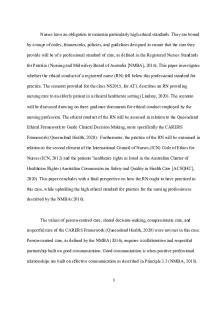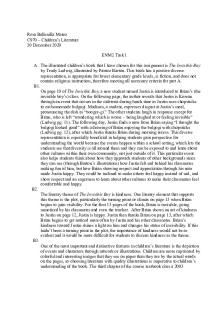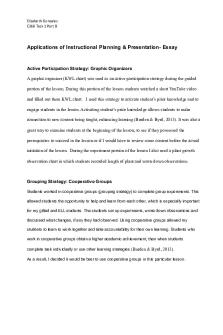IFB104 Assessment Task 1 Overview PDF

| Title | IFB104 Assessment Task 1 Overview |
|---|---|
| Course | Building IT Systems |
| Institution | Queensland University of Technology |
| Pages | 6 |
| File Size | 354.2 KB |
| File Type | |
| Total Downloads | 75 |
| Total Views | 133 |
Summary
Assignment 1...
Description
ASSESSMENT TASK 1 IFB104 BUILDING IT SYSTEMS
This document provides you with information about the requirements for assessment. Detailed instructions and resources are included to help you to complete and submit the task. The Criterion Reference Assessment (CRA) Rubric that markers use to grade the assessment task is included and should be used as a guide when working on it.
Task Overview Assessment name:
Assignment 1: Data Visualisation
Task description:
Here you will develop a complete computer program which draws a visualisation of given data sets. The data sets are generated by a template program which you must extend to complete your solution. To do so you will need to design appropriate symbols for the visualisation and develop program code capable of processing any given data set and accurately drawing a complete corresponding image.
Learning outcomes measured:
ULO 2: Effectively use some of the many computer languages needed to build IT systems. ULO 3: Apply appropriate processes and creative thinking to develop solutions to small IT challenges.
Due Date:
Part A, static images: Sunday, March 28th, 2021, 23:59 (end of Week 4) Part B, complete solution: Sunday, April 25th, 2021, 23:59 (end of Week 7)
Estimated time to complete task:
Approximately 30 hours
Weighting:
Part A: 7% of final grade Part B: 23% of grade
Individual or Group:
Individual
Authentic Assessment:
Yes
Formative/Summative:
Summative
How will I be assessed:
Grading scale using a supplied rubric
IFB104 BUILDING IT SYSTEMS: ASSESSMENT TASK 1
1
ASSESSMENT TASK 1 IFB104 BUILDING IT SYSTEMS
Task details What you need to do:
Part A: 1. Read the Criterion Reference Assessment Rubric. 2. Study the “client’s requirements” for the assignment (on Blackboard). 3. Download the relevant program template (from Blackboard) and familiarise yourself with the drawing canvas it creates. 4. Design the symbols to be used for your visualisation and create program code to draw them. 5. Submit Part A (to Blackboard) by the due date above. Part B: 6. Read the Criterion Reference Assessment Rubric. 7. Complete the program code as per the client’s requirements to draw appropriate visualisations of any possible data set that can be generated by the client’s data function. 8. Upload drafts of your solution (to Blackboard) as you make progress. 9. Be prepared to respond to last-minute changes in the requirements made by the “client”. 10. Submit Part B (to Blackboard) by the due date above.
Presentation requirements:
Resources needed to complete task:
•
See the IFB104 Code Presentation Guide (on Blackboard) for tips on code layout.
•
See the assignment’s requirements (on Blackboard) for examples of the standard expected of the program’s output.
•
Your program must run in a standard Python 3 environment with no extensions. You may not use any Python modules that need to be downloaded and installed separately, such as “Beautiful Soup” or “Pillow”. Only modules that are part of a standard Python 3 installation may be used.
The following items will be made available on Blackboard: • Assignment 1 program template • The “client’s requirements” for the program
IFB104 BUILDING IT SYSTEMS: ASSESSMENT TASK 1
2
ASSESSMENT TASK 1 IFB104 BUILDING IT SYSTEMS
Submission Information What you need to submit:
Upload your completed version of the program template, as a single, self-contained program file, after checking the following points: 1. You have added your name and student number to the state-
ment of authorship at the top. 2. Your program code runs without “crashing” (generating un-
handled exceptions), even if your solution is incomplete. You will receive partial marks for incomplete solutions. 3. Your program code runs in a standard Python 3 environment
and does not rely on any separately installed extension modules. How to submit:
A link will be made available on the IFB104 Blackboard site under Assessment Task 1 for uploading your solution file. 1.
Click on the Submit Assessment Task 1A or Task 1B link.
2.
Drag your Assessment file into the Attach Files box or click on the Browse My Computer button to locate your file.
3.
Add any comments you wish to make to the teaching staff in the Comments textbox.
4.
Click the Submit button.
Notes:
What feedback will I receive?
•
You can submit as many drafts of your solution as you like. You are strongly encouraged to submit several draft solutions before the final submission date as insurance against computer or network problems near the deadline.
•
If you are unsure whether or not you have successfully uploaded your file, upload it again!
•
If you encounter problems uploading your files to Blackboard contact HiQ’s Technology Services for advice (http://qut.to/ithelp; [email protected]; 3138 2000).
•
Do not email assignments to the teaching staff. Teaching staff cannot submit assignments to Blackboard on a student’s behalf, and Python files are blocked by Microsoft Outlook and will not be received.
Under normal circumstances, you will receive marks for each criterion via a Blackboard rubric within 15 days of submission. Click on your mark in MyGrades to see the rubric. Usually, the
IFB104 BUILDING IT SYSTEMS: ASSESSMENT TASK 1
3
ASSESSMENT TASK 1 IFB104 BUILDING IT SYSTEMS
reason for each choice of mark is self-evident, but sometimes the marker will add a few words of explanation. You should use this feedback to strengthen your performance in the next assessment item. Moderation:
All staff who are assessing your work meet to discuss and compare their judgements before marks or grades are finalised.
Academic Integrity As a student of the QUT academic community, you are asked to work to uphold the principles of academic integrity during your course of study. QUT sets expectations and responsibilities of students, more specifically it states that students “adopt an ethical approach to academic work and assessment in accordance with this policy and the Student Code of Conduct. E/2.1 (MOPP C/5.3 Academic Integrity). At university, students are expected to demonstrate their own understanding and thinking using the ideas provided by ‘others’ to support and inform their work, always making due acknowledgement to the source. While we encourage peer learning, it is not appropriate to share assignments with other students unless your assessment piece has been stated as being a group assignment. If you do share your assignment with another student, and they copy part of or all of your assignment for their submission, this is considered collusion and you may also be reported for academic misconduct. If you are unsure and need further information you can find this at: http://www.mopp.qut.edu.au/C/C_05_03.jsp#C_05_03.03.mdoc.
IFB104 BUILDING IT SYSTEMS: ASSESSMENT TASK 1
4
IFB104 | Building IT Systems | Assignment 1 (30% of Final Grade) Criteria
Perfect
High Distinction
Distinction
Credit
Pass
Marginal Fail
Fail
Low Fail
No Evidence
Good but noticeable weaknesses with the images and/or text, e.g., unclear captions, poor layout, or overly similar images. (4%)
Significant parts of the required images and text are missing, substandard or trivial. (3.2%)
Very little done, e.g., only one or two trivial images drawn and/or images differ only in a trivial way (e.g., colour). (2.3%)
A few shapes or lines drawn, or some text written, but the main requirements are not satisfied significantly. (0.9%)
No evidence of addressing this criterion. (0%)
PART A: Static parts of visualisation drawn correctly Weight (of final grade): 7%
All required images and text are well-designed, sufficiently detailed, and drawn correctly. (7%)
Excellent but a minor problem with one of the images, e.g., a misplaced line, or a small part of the text, e.g., a spelling error. (6.5%)
Images are well-designed and sufficiently detailed, but a slight problem with one of the drawings or a part of the text. (5.6%)
Generally good but some small elements are wrong or missing, or the images are not entirely distinct and recognisable. (4.9%)
PART B: Data is processed correctly Weight: 10%
All possible data sets are processed correctly (and this is made clearly evident to the user). (10%)
Dynamic parts The visual inof visualisaterpretation of all possition drawn ble data sets correctly is accurate, well-deWeight: 8% signed and complete.
All data sets are processed correctly, apart from an extreme case, e.g., the empty set. (9.3%)
All data sets are processed correctly, apart from a few special cases. (8%)
The program works with almost all data sets but not some having a particular characteristic. (7%)
The program works correctly with the majority of data sets but not a significant minority. (5.8%)
The program cannot correctly process most data sets or works only with selected, fixed data sets. (4.5%)
The program is hardwired to work with only a few fixed data sets. (3.3%)
Program code cannot run to completion or is hardwired to produce a fixed result only. (1.3%)
No evidence of addressing this criterion. (0%)
Excellent apart from some minor defect in the drawing, e.g., one element slightly out of place.
All data sets are visualised accurately and completely, but there is some minor flaw in a few
The visualisation is drawn accurately in almost every case, but in a few there
The visualisation is drawn accurately in the majority of cases, but in some situations there
Significant problems with the visualisation in many cases , e.g., images missing, incorrect or
Some small parts of the necessary visualisation are drawn but the result is largely incomplete,
Program code cannot run to completion or draws just a few fixed shapes or lines.
No evidence of addressing this criterion. (0%)
IFB104 BUILDING IT SYSTEMS: ASSESSMENT TASK 1
5
ASSESSMENT TASK 1 IFB104 BUILDING IT SYSTEMS
Code conciseness, clarity and presentation Weight: 5%
(8%)
(7.4%)
cases, e.g., stray or missing lines (6.4%)
are small errors. (5.6%)
are noticeable errors. (4.6%)
drawn in the wrong locations. (3.6%)
inaccurate and/or incoherent. (2.6%)
(1%)
All code is concise, neatly laid out, uses meaningful identifiers, and is commented helpfully. (5%)
Excellent but with a minor flaw such as a misleading comment, an obscure choice of identifier, etc. (4.6%)
One or two substandard elements such as uninformative identifiers ("i", "j", "n", etc) or inadequately commented code blocks. (4%)
Generally good but a few uninformative identifiers, inadequately commented blocks, or unnecessarily duplicated code segments. (3.5%)
Good but some significant segments are hard to understand due to poor commenting or identifier choices, or significant amounts of unnecessary duplication. (2.9%)
Insufficient commenting in many parts, many unhelpful identifiers, and/or large amounts of unnecessarily duplicated code. (2.3%)
Little code to assess and/or barely any commenting and/or large amounts of confusing, unnecessarily duplicated code. (1.6%)
Very little code to assess or code is inadequately presented throughout. (0.6%)
No evidence of addressing this criterion. (0%)
IFB104 BUILDING IT SYSTEMS: ASSESSMENT TASK 6...
Similar Free PDFs

BSBPMG522 Assessment Task 1
- 9 Pages

Assessment TASK 1 – Scenario
- 5 Pages

Assessment Task 1
- 2 Pages

Reflection Assessment Task 1
- 4 Pages

NS2015 Assessment Task 1
- 7 Pages

Assessment Task
- 3 Pages

Community Overview Assessment
- 3 Pages

Bsbcrt 412 - Assessment Task 1
- 5 Pages

Bsbcmm 511 - Assessment Task 1
- 14 Pages

AIR200 Assessment Overview
- 4 Pages
Popular Institutions
- Tinajero National High School - Annex
- Politeknik Caltex Riau
- Yokohama City University
- SGT University
- University of Al-Qadisiyah
- Divine Word College of Vigan
- Techniek College Rotterdam
- Universidade de Santiago
- Universiti Teknologi MARA Cawangan Johor Kampus Pasir Gudang
- Poltekkes Kemenkes Yogyakarta
- Baguio City National High School
- Colegio san marcos
- preparatoria uno
- Centro de Bachillerato Tecnológico Industrial y de Servicios No. 107
- Dalian Maritime University
- Quang Trung Secondary School
- Colegio Tecnológico en Informática
- Corporación Regional de Educación Superior
- Grupo CEDVA
- Dar Al Uloom University
- Centro de Estudios Preuniversitarios de la Universidad Nacional de Ingeniería
- 上智大学
- Aakash International School, Nuna Majara
- San Felipe Neri Catholic School
- Kang Chiao International School - New Taipei City
- Misamis Occidental National High School
- Institución Educativa Escuela Normal Juan Ladrilleros
- Kolehiyo ng Pantukan
- Batanes State College
- Instituto Continental
- Sekolah Menengah Kejuruan Kesehatan Kaltara (Tarakan)
- Colegio de La Inmaculada Concepcion - Cebu





